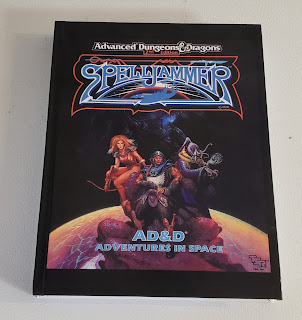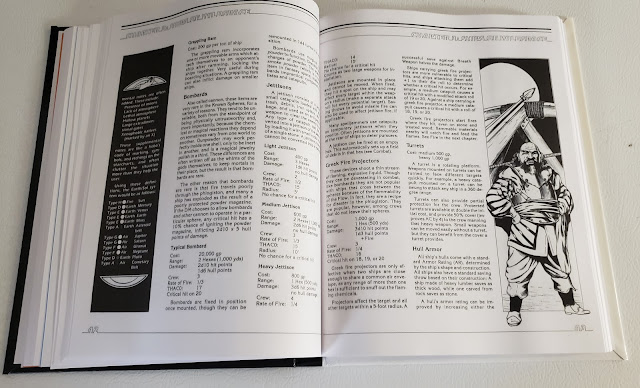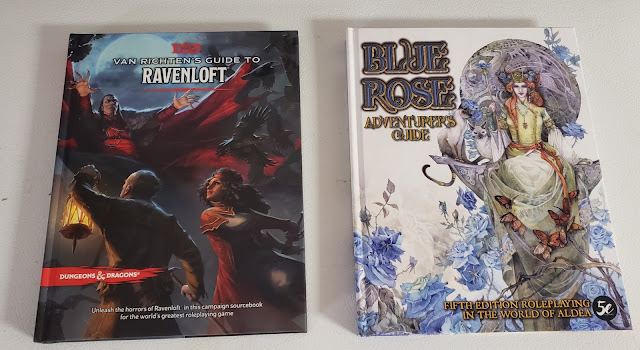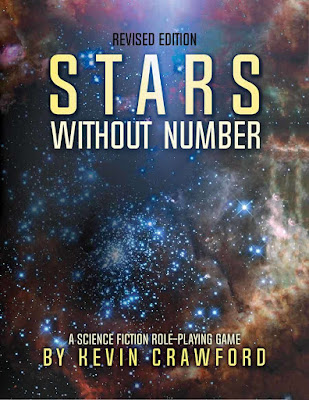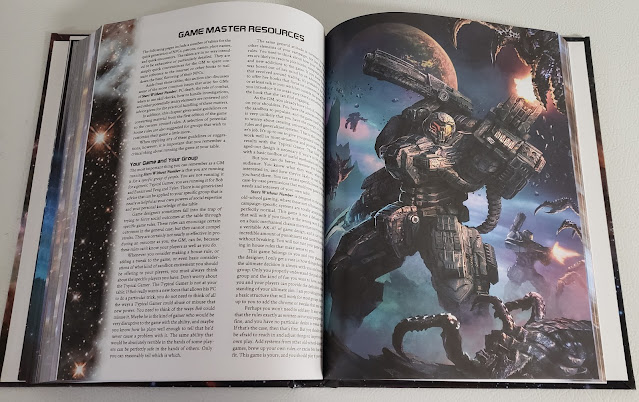(Ok, technically the roots of the Internet were here in ARPANet and what I was using BitNet at the time. But you know what I mean.)
The time is 1989 and the game on my table is AD&D 2nd Edition. Well, it is really Ravenloft, because, in college that was my setting of choice, AD&D just happens to be the system that ran underneath it all. So a couple of points already. I was playing AD&D 2nd Ed and really all I had the money for at the time was for one setting and that was Ravenloft. There were a lot of great settings in the AD&D 2 days; Forgotten Realms loomed large and impressive, and maybe a little intimidating. Greyhawk and Mystara only had some minor entries, much to my disappointment, Al-Qadim and Kara-Tur both looked like fun, and then we would also get Planescape. But there was one out that seemed so strange to me that I wanted to know more but yet could not bring myself to buy. Until now.
DriveThruRPGs Print on Demand has been a fantastic opportunity for those of us who want to go back and look at some of these other systems and games of our youth. While I have relied mostly on the aftermarket to get myself up to speed on the Forgotten Realms (and enjoying it) I recently picked up the hardcover POD version of AD&D's Spelljammer. And I am so happy I did.
Now don't get me wrong. I wanted to play SpellJammer back then. We ever started a new campaign where all the characters were in a navy, so they all had 3 free levels in fighter, and then they were level 1 (or 4 for the fighters) in whatever other classes they were going to be. Using the AD&D dual classing rules meant they could not act as fighters until later. But it boosted their HP. They were going to spend some time at sea, but eventually, they were going to turn their ship into a SpellJamming one. I named the ship "The Black Betty" after the Ram Jam song because every time I heard "Spelljammer" I thought "ram jam" and the Black Betty was a good name for a ship. Sadly we never got very far. I was at University and my DM at the time was at a different school and the other players were also at yet another school. Meeting only over the summer was not helpful for a long-term campaign.
Fast forward to today.
Spelljammer: Adventures in Space
For this review, I am considering the Print on Demand hardcover and the PDFs from DriveThruRPG. There may be things true of these versions that are not true for the original boxed set and things that might be the other way around. I can't speak to the boxed set since I never owned it.
Spelljammer is a whopping 278 pages. Jeff Grubb is our primary author with art by Jeff Easley, Jim Holloway, Dave "Diesel" LaForce, and Roy Parker. Easley is responsible for our cover, and indeed many of the covers from this time. The interior art is Jim Holloway who really set the tone and feel for what I consider the 2nd Ed "style" of that time. The interior is largely black and white with some color illustrations. Mostly the pictures of ships, what were covers in the separate boxed set books, and some maps. The scanned pages are not crisp, but they are easy to read.
The book is divided into two large sections that correspond to the two 96-page books that came in the boxed set, Lorebook of the Void and Concordance of Arcane Space.
Lorebook of the Void
We are introduced to how Spelljammer, AD&D in Space, came about. We also now know that this was the first of new boxed set settings to come out for AD&D 2nd ed. More would follow and make 2nd Ed more famous for their settings rather than their rules. The goal for Spelljammer was overtly a simple one; AD&D in space, connect all the main AD&D worlds, and make them work together without changing what makes each one unique.
This section covers the basics of Spelljamming and operating a spelljamming helm. We get a good overview of the types of spelljamming ships and that various races that can be found in Arcane Space. We learn that gnomes and halflings for the most part avoid Arcane Space since they are too closely tied to their planets (makes sense) but Krynn's Tinker Gnomes are not so tied to their world in the same fashion so they are very much at home in Arcane Space. We even get a bit on goblinoids.
The next third covers the various monsters and creatures you will find in AD&D 2nd Ed Monstrous Compendium format. We are given new details on the Beholders (they take the place of Daleks in Arcane Space) and the Neogi. Mind Flayers also get new treatments.
The last thrid covers the three main AD&D game worlds, Krynn (Dragonlance), Oerth (World of Greyhawk), and Toril (Forgotten Realms). The problems begin to show here since the cosmology of Krynn is tied very much to their gods. This is not the fault of Spelljammer or Dragonlance, but rather one of trying to fit the divine into a scientific worldview. I will admit I do like how the spheres are covered here. It reminds me a little of how the solar system of Urt is covered in the D&D Immortals Set. One could take that information and drop it rather cleanly into this book. It was not done of course because at this time Urt/Mystara was considered part of D&D and not AD&D. Even discussions online close to the time described AD&D as one universe, maybe even in the same galaxy, and D&D in a different universe altogether.
Concordance of Arcane Space
The second major section of the book covers the rules part of Arcane Space. The first chapter describes some basics of how Arcane Space and the Phlogiston work. Chapter 2 covers some changes to the AD&D rules. The first change, Lizard Men are now a playable race. There are changes to some spells and how clerics can talk to their gods. We also get some new spells. Chapter 3 covers the ships. How they are made, flown, and the capabilities (armor, weapons, storage) of examples. Combat is covered in Chapter 4. Ships are a lot like characters in they have an Armor Rating and Hull Points. Damage by large ship weapons can deal hull damage and/or hit point damage. Chapter 5 covers celestial mechanics, or how systems are made. While in real-life astrophysics we know that forces like gravity will produce round (or oblate) planets and stars, there is a wide variety of things found even nearby to us. Arcane Space should be just as diverse if not more so. Oerth (Greyhawk) is a Geocentric system, Toril and Krynn are heliocentric. There are other systems that can be and should be, even stranger. We learn that there is a flow to the Phlogiston and that some worlds might easy to travel to, but harder to travel away from.
We also have several appendices. The first covers how magic spells and items work in space. Appendix 2 covers travel times with Earth and the Solar System as an example along with Krynn, Toril, and Oerth. Mystara/Urt can be substituted for Earth easy enough. Flow can affect travel times.
The last section of the book are the color deck plans of various spelljamming ships. Maps and cut-out-and-fold ship minis. Best get the PDF along with the printed book so you can print these on your own. A large black-hex map would work great for movement in space.
Reading it today I can overlook some of the flaws that would have bothered me in 1990.
Print on Demand Book
The Print on Demand book is hardcover, mostly black & white with some color art inside and color covers. It is a hefty volume on premium paper which makes it a little thicker than you expect a 278-page book to be. It is very high quality.
Converting to 5e
In the first chapter of the first section, some advice is given about converting older AD&D monsters to use with Spelljammer since in theory every monster could be found somewhere. The example given is the Grimlock from the Fiend Folio, a monster they describe as not likely to be updated to 2nd Edition.
Well. We know now the Grimlock. And updated to 3rd and beyond. So there is no good reason to assume that Spelljammer will "Never" be updated. In fact with D&D 5's desire to embrace the past and every world of D&D in their products it is reasonable we will see some Spelljammer at some point. A spelljamming ship was already placed on a level in a 5th edition adventure.
But converting to 5e based on the material in this book? Well really there are two main areas of focus; monsters and magic. Many of the monsters have newer 5e writeups now, so this is less a question of conversion and more of replacement. Magic, in particular spells, would need some more work but the guidelines are in place. Similar spells should change in similar manners. Combat can be swapped out for 5e combat, which not terribly different. So yes, if you are playing a 5e game then you can get a lot of use and play out of this book.
If you have ever been curious about Spelljammer but did not want to pay the aftermarket prices then the PDF is an absolute steal. If you know about it and want to give it a go again (or for the first time) then the POD version is equally cost-effective.


